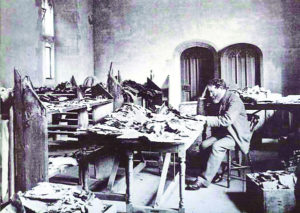
Solomon Schechter studying fragments from the Geniza. (University of Cambridge, permission of the Syndics of Cambridge University Library)
An exhibition at Cambridge University featuring a fraction of ancient Jewish manuscripts that are part of the unique collection known as the Cairo Geniza will open in April, 2017.
Titled “Discarded History,” the exhibit displays a small percentage of 300,000 manuscripts originally found in the geniza, or storeroom, of the Ben Ezra Synagogue in Fustat. Some documents date back over 1,000 years.
According to the rabbis, Jews must not destroy a manuscript that contains the name of G-d. This instruction was subsequently extended to include clear references to G-d, or religious texts written in Hebrew letters, as they regarded Hebrew as the sacred language.
In order to ensure that the name of G-d was not being violated, even accidently, the Jews of Fustat periodically collected their worn out texts and documents and placed them in a storeroom.
In 1896, Scottish twin sisters Agnes Smith Lewis and Margaret Dunlop Gibson visited Cairo during their many travels in the area.
The twins, members of the Presbyterian Church, were both Semitic scholars who were well versed in ancient and contemporary European languages.
During their travels in Egypt they bought bundles of manuscripts, some of which had been taken from the geniza of the Ben Ezra Synagogue.
On their return to England, the sisters showed some of their purchases to their friend Solomon Schechter.
Schechter was a rabbi and academic who, at the time, was teaching Rabbinics and Talmud at Cambridge University.
Schechter was already familiar with the existence of the geniza, but did not realize the extraordinary significance of its contents or the fact that the documents spanned 1,000 years of Jewish history and personalities.
He decided to go to Egypt to investigate further.
Schechter received permission to examine the contents of the geniza and to take whatever he liked. As he later said, “I liked it all.”
Schechter subsequently removed most of the manuscripts from the Ben Ezra Synagogue geniza and brought them back to Cambridge. As he began to evaluate hundreds of items, he realized that this collection of documents was an unprecedented window on Jewish life.
Among the treasures is a small section of manuscript that is thought to be the oldest known Ashkenazi fragment dating from the 11th century. Another manuscript, written by Moses Maimonides, is a hand-written draft of the Guide for the Perplexed. Another was penned by Joseph Caro.
The religious and civil documents discovered in the Cairo Geniza provide scholars with copious pieces of information that, when they are all itemized and collated, will be a window on Jewish secular and religious life over the past 10 centuries.
















